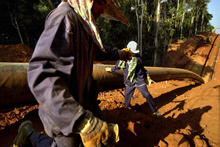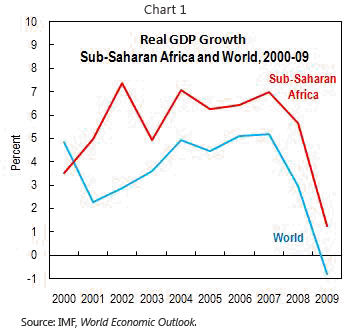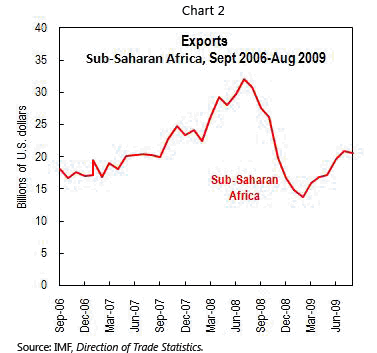
Typical street scene in Santa Ana, El Salvador. (Photo: iStock)
IMF Survey: All About Goals as Africa Shows Signs of Recovery
January 7, 2010
- African exports growing again as world commodities rally from 2008 lows
- Government stimulus measures are helping to sustain output
- External finance set to support region’s recovery in 2010
World attention will fall on South Africa as it hosts the soccer World Cup later this year, but a successful tournament won’t be the only goal in the sights of African countries.

Growing local markets, improving political stability and public infrastructure, and lower costs providing strong incentives for inward investment (photo: Newscom)
AFRICA IN 2010
After the battering that their economies received from world developments last year, countries in sub-Saharan Africa will be aiming at speedy economic recovery in 2010, and at resumed progress toward the Millennium Development Goals. Here, at least, prospects are brightening.
Recent performance is very much on the side of African economies. Between 2002 and 2007, GDP in sub-Saharan Africa rose at an average annual rate of over 6 percent, consistently higher than the world average (see Chart 1). At the same time, inflation was generally contained at moderate levels, government finances improved, and international reserves rose.

But that was before the region was put on the defensive by world developments; first, the worldwide price hikes for food and fuel in early 2008, and then the global financial crisis and recession. These events led to a marked slowdown in growth throughout sub-Saharan Africa, with commodity exporters suffering sharp cuts in demand for their products and South Africa falling into recession. In 2009, it seems likely that GDP growth in the region was only 1 percent.
Signs of recovery
The good news for 2010 is that signs of recovery in GDP are already appearing. Industrial production began to pick up in South Africa in the third quarter of 2009. Throughout the region, exports have been rising strongly since the second quarter of 2009, reversing much of the hemorrhaging that began in the third quarter of 2008 (see Chart 2).

In the private sector, consumers and businesses seem to have cut back less during the global recession than in some other regions. Indeed, while the risks remain sizable, and the maintenance of the global recovery will be critical, all the economic indicators for sub-Saharan Africa are now consistent with a bounce-back in activity. In its October 2009 World Economic Outlook, the IMF looked for GDP growth in sub-Saharan Africa of about 4 percent in 2010.
A critical factor in cementing this recovery will be the behavior of the public sector. In 2009, it was the decision by many sub-Saharan African countries to allow government deficits to rise in the face of revenue shortfalls, and to reduce policy interest rates, that helped their economies absorb some of the impact of the external shocks. The IMF strongly supported these policies, in part by committing over $4 billion of new lending to countries in the region in 2009. Where feasible, continued stimulus by some countries in early 2010 is likely to be helpful, particularly if world growth proves fragile.
Dented public finances
At the same time, however, governments must have coherent plans to bring public finances and monetary aggregates back on track. Once economic recovery is established, countries will need to cover the dent in their finances made by the slowdown, adjust to possibly lower levels of potential output— and hence revenue— in the medium term, and ensure that they have adequate fiscal space to deal with future negative shocks and restructuring needs. A retrenchment in spending plans seems likely to be necessary.
Efforts by governments to improve their business climates and open their markets yielded strong returns in the mid-2000s. The private sector became the main engine of growth. The 10 or so sub-Saharan African countries identified as “frontier markets” became the recipients of increased inflows of foreign capital in the period.
Although some of this capital proved volatile in the global financial crisis, the omens are positive for 2010. First, foreign direct investment seems generally to have been more stable during the slowdown. Second, sub-Saharan Africa is already benefiting from the recent recovery in global markets’ risk appetite. Third, and most important, countries have remained “open for business” during the downturn, with very little resort to old-style controls on activity. Growing local markets, improving political stability and public infrastructure, and a lower cost base are providing strong incentives for inward investment.
Private capital
As so often in the past, external finance will be crucial in sustaining sub-Saharan Africa’s recovery in 2010. Private capital will be critical for businesses to be able to expand trade and undertake new investment. But it may also be increasingly a source of finance for the public sector.
With global financial markets again looking for opportunities, a growing number of sub-Saharan African countries are considering turning to international bond markets, some for the first time. Meanwhile, the IMF and other multilateral institutions will be standing by in 2010 to support governments with reinforced liquidity and an improved array of flexible and fast-disbursing lending facilities. From a strong defense during the past year, African economies should be able to go back on offense in 2010.
■ Building on pledges at a two-day conference of African finance officials, business leaders, and academics in Dar es Salaam, Tanzania in 2009, senior IMF officials are scheduled to visit Africa early in 2010. Managing Director Dominique Strauss-Kahn plans to visit central and southern Africa in March, following a trip scheduled by First Deputy Managing Director John Lipsky to west Africa in February.


